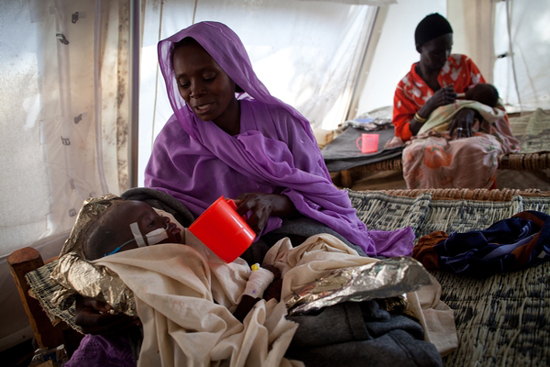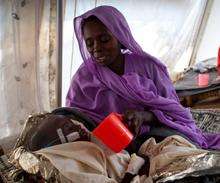MSF nutritional and retrospective mortality survey finds mortality double the emergency threshold

South Sudan 2012 © Nichole Sobecki
Asha Jibril cares for her malnourished two-year-old daughter Aziza Haran in the ITFC at MSF's field hospital in Batil camp.
Many of the refugees from Sudan’s Blue Nile State who have fled to Maban County in South Sudan’s Upper Nile State had family members who could not complete the journey and died before they reached Batil camp. In some cases, they said their relatives died because they were “tired of walking,” which illustrates the weakened, vulnerable state in which much of this population arrived at the camp. It also points to the massive need for assistance for those that managed to arrive alive.
Mortality More Than Double Emergency Levels[1]
Data gathered by Doctors Without Borders/Médecins Sans Frontières (MSF) epidemiological teams support this assertion. Mortality for the total refugee population in Batil is substantially above the emergency threshold, and mortality for children under five is more than double the emergency threshold.
Technically, the data shows mortality rates of 1.75 out of 10,000 per day overall and 4.2 out of 10,000 per day for children under five, well above the emergency thresholds of 1 and 2 out of 10,000 per day respectively.
To put this in perspective, for children under five, this is more than double the emergency threshold, and more than four times the norm in a low-resource setting—meaning that four times as many children are dying now in Batil than we would expect to see if everything were “normal.”
To put it in other words: between three and four children under five years old have been dying on average every day in Batil camp. Fifty-eight percent of reported deaths among the refugees since they arrived in Batil camp have been children under five years old.
Additionally, though, more than 25 percent of reported deaths were for people older than 50. In many emergency interventions, children under five are the first priority, but to see this level of mortality in over-fifties is unexpected and serves of further indication of a very vulnerable and weak population.
Cause of Death
Diarrhea has been the cause of death for more than 90 percent of fatalities reported while these refugees have been in Batil, an astounding number. Malnutrition was a factor in many of the deaths.
Shocking Malnutrition
More than quarter of the children under five in the camp—27.7 percent, to be precise—are malnourished, and 10 percent are in the most severe acute stage of malnutrition and require urgent therapeutic feeding.
Even more shocking, 44 percent of the children under two years old are malnourished, with 18 percent of them being in the most severe, potentially life-threatening stage of malnutrition.
Respiratory Diseases Rising
While respiratory tract infections constituted around 10 percent of consultations in Batil in June, they have been rising alarmingly and last week constituted more than 40 percent of the consultations in the camp.
MSF Response
MSF has more than 180 expatriate staff and more than 800 locally recruited staff on the ground in the five refugee camps for Sudanese refugees in South Sudan. The first emergency interventions were started in November 2011 when refugees first arrived in Yida and Doro camps in Unity and Upper Nile States, respectively. MSF rapidly expanded its emergency activities over the following months as the number of refugees grew, as the rainy season started, and as the health situation in the camps deteriorated.
In its tented field hospital in Batil camp, MSF now has more than 1,600 children suffering from severe acute malnutrition in the therapeutic feeding program. Every week, about 30 of these children need to be admitted into intensive care with life-threatening medical complications such as diarrhea or respiratory diseases. Since the Batil camp was set up in May, MSF has conducted more than 14,500 medical consultations, while also assisting with the set-up of water distribution networks and the distribution of basic survival essentials.
Conclusion:
“This new data reflects exactly what I see every day,” says Helen Patterson, MSF’s medical coordinator for Batil camp. “This is a health catastrophe. With nearly half the children under two years old malnourished, and living in cold, wet conditions, and hundreds falling ill with diarrhea and respiratory diseases, our field hospital is overwhelmed with critically ill patients. We’re pushing the boundaries of what’s possible logistically to get staff and supplies here and continue saving lives.”
Note on time period of the data presented:
The mortality data presented here focuses entirely on the period since the refugees arrived in the camp. The arrival date for households in the camp differed depending on village. The households had arrived in Batil refugee camp between May 2, 2012 and July 14, 2012. To calculate both the recall period before arrival in the camp and while being in the camp to assess mortality accordingly, the recall period was calculated for each individual, individually.
[1]Emergency thresholds and 'norm' levels
- Crude Mortality Rate (total population) of 1/10.000/day and under-five-yrs-old Mortality Rate of 2.0/10.000/day are commonly used as the thresholds of gravity in emergency situations.
- CMR of 0.5/10.000/day and U5MR of 1.0/10.000/day are levels considered 'normal' for developing countries (UNHCR, 2002; MSF, 2006)




